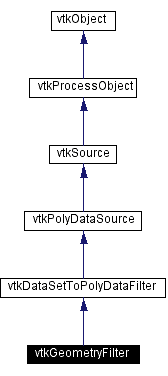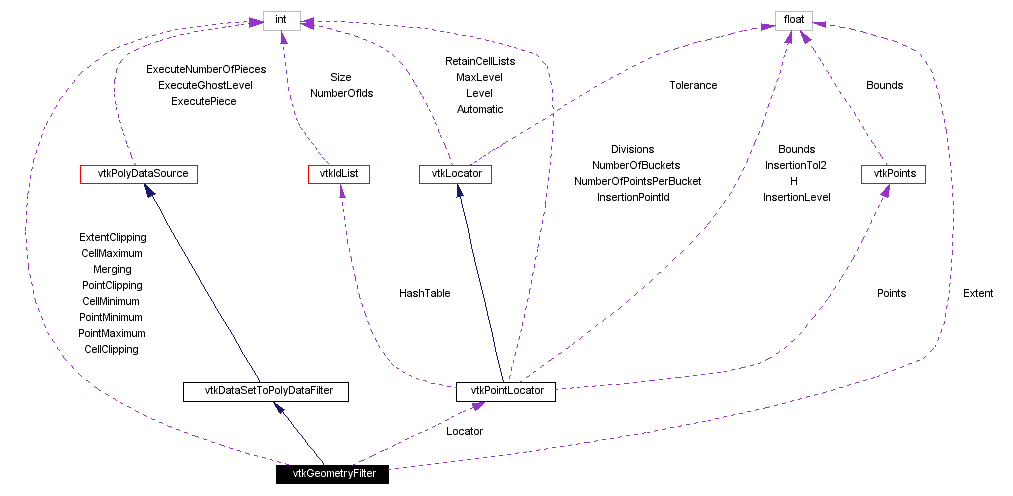Main Page Class Hierarchy Alphabetical List Compound List File List Compound Members File Members Related Pages
vtkGeometryFilter Class Reference
extract geometry from data (or convert data to polygonal type).
More...
#include <vtkGeometryFilter.h>
Inheritance diagram for vtkGeometryFilter:
 [legend]Collaboration diagram for vtkGeometryFilter:
[legend]Collaboration diagram for vtkGeometryFilter: [legend]List of all members.
[legend]List of all members.
Detailed Description
extract geometry from data (or convert data to polygonal type).
-
Date:
-
2000/12/10 20:08:38
-
Revision:
-
1.45
vtkGeometryFilter is a general-purpose filter to extract geometry (and associated data) from any type of dataset. Geometry is obtained as follows: all 0D, 1D, and 2D cells are extracted. All 2D faces that are used by only one 3D cell (i.e., boundary faces) are extracted. It also is possible to specify conditions on point ids, cell ids, and on bounding box (referred to as "Extent") to control the extraction process.
This filter also may be used to convert any type of data to polygonal type. The conversion process may be less than satisfactory for some 3D datasets. For example, this filter will extract the outer surface of a volume or structured grid dataset. (For structured data you may want to use vtkStructuredPointsGeometryFilter, vtkStructuredGridGeometryFilter, vtkUnstructuredGridGeometryFilter, vtkRectilinearGridGeometryFilter, or vtkExtractVOI.)
-
Warning:
-
When vtkGeometryFilter extracts cells (or boundaries of cells) it will (by default) merge duplicate vertices. This may cause problems in some cases. For example, if you've run vtkPolyDataNormals to generate normals, which may split meshes and create duplicate vertices, vtkGeometryFilter will merge these points back together. Turn merging off to prevent this from occurring.
-
See also:
-
vtkStructuredPointsGeometryFilter vtkStructuredGridGeometryFilter vtkExtractGeometry vtkExtractVOI
-
Examples:
-
vtkGeometryFilter (examples)
Definition at line 81 of file vtkGeometryFilter.h.
Constructor & Destructor Documentation
| vtkGeometryFilter::vtkGeometryFilter |
( |
|
) |
[protected] |
|
| vtkGeometryFilter::~vtkGeometryFilter |
( |
|
) |
[protected] |
|
| vtkGeometryFilter::vtkGeometryFilter |
( |
const vtkGeometryFilter & |
|
) |
[inline, protected] |
|
Member Function Documentation
| vtkGeometryFilter* vtkGeometryFilter::New |
( |
|
) |
[static] |
|
|
|
Instantiate object with no start, end, or progress methods.
Reimplemented from vtkPolyDataSource. |
| virtual const char* vtkGeometryFilter::GetClassName |
( |
|
) |
[virtual] |
|
| int vtkGeometryFilter::IsTypeOf |
( |
const char * |
type |
) |
[static] |
|
|
|
Return 1 if this class type is the same type of (or a subclass of) the named class. Returns 0 otherwise. This method works in combination with vtkTypeMacro found in vtkSetGet.h.
Reimplemented from vtkDataSetToPolyDataFilter. |
| virtual int vtkGeometryFilter::IsA |
( |
const char * |
type |
) |
[virtual] |
|
|
|
Return 1 if this class is the same type of (or a subclass of) the named class. Returns 0 otherwise. This method works in combination with vtkTypeMacro found in vtkSetGet.h.
Reimplemented from vtkDataSetToPolyDataFilter. |
| vtkGeometryFilter* vtkGeometryFilter::SafeDownCast |
( |
vtkObject * |
o |
) |
[static] |
|
| void vtkGeometryFilter::PrintSelf |
( |
ostream & |
os, |
|
|
vtkIndent |
indent |
|
) |
[virtual] |
|
|
|
Methods invoked by print to print information about the object including superclasses. Typically not called by the user (use Print() instead) but used in the hierarchical print process to combine the output of several classes.
Reimplemented from vtkSource. |
| virtual void vtkGeometryFilter::SetPointClipping |
( |
int |
|
) |
[virtual] |
|
|
|
Turn on/off selection of geometry by point id. |
| virtual int vtkGeometryFilter::GetPointClipping |
( |
|
) |
[virtual] |
|
| virtual void vtkGeometryFilter::PointClippingOn |
( |
|
) |
[virtual] |
|
| virtual void vtkGeometryFilter::PointClippingOff |
( |
|
) |
[virtual] |
|
| virtual void vtkGeometryFilter::SetCellClipping |
( |
int |
|
) |
[virtual] |
|
|
|
Turn on/off selection of geometry by cell id. |
| virtual int vtkGeometryFilter::GetCellClipping |
( |
|
) |
[virtual] |
|
| virtual void vtkGeometryFilter::CellClippingOn |
( |
|
) |
[virtual] |
|
| virtual void vtkGeometryFilter::CellClippingOff |
( |
|
) |
[virtual] |
|
| virtual void vtkGeometryFilter::SetExtentClipping |
( |
int |
|
) |
[virtual] |
|
|
|
Turn on/off selection of geometry via bounding box. |
| virtual int vtkGeometryFilter::GetExtentClipping |
( |
|
) |
[virtual] |
|
| virtual void vtkGeometryFilter::ExtentClippingOn |
( |
|
) |
[virtual] |
|
| virtual void vtkGeometryFilter::ExtentClippingOff |
( |
|
) |
[virtual] |
|
| virtual void vtkGeometryFilter::SetPointMinimum |
( |
int |
|
) |
[virtual] |
|
|
|
Specify the minimum point id for point id selection. |
| virtual int vtkGeometryFilter::GetPointMinimum |
( |
|
) |
[virtual] |
|
| virtual void vtkGeometryFilter::SetPointMaximum |
( |
int |
|
) |
[virtual] |
|
|
|
Specify the maximum point id for point id selection. |
| virtual int vtkGeometryFilter::GetPointMaximum |
( |
|
) |
[virtual] |
|
| virtual void vtkGeometryFilter::SetCellMinimum |
( |
int |
|
) |
[virtual] |
|
|
|
Specify the minimum cell id for point id selection. |
| virtual int vtkGeometryFilter::GetCellMinimum |
( |
|
) |
[virtual] |
|
| virtual void vtkGeometryFilter::SetCellMaximum |
( |
int |
|
) |
[virtual] |
|
|
|
Specify the maximum cell id for point id selection. |
| virtual int vtkGeometryFilter::GetCellMaximum |
( |
|
) |
[virtual] |
|
| void vtkGeometryFilter::SetExtent |
( |
float |
xMin, |
|
|
float |
xMax, |
|
|
float |
yMin, |
|
|
float |
yMax, |
|
|
float |
zMin, |
|
|
float |
zMax |
|
) |
|
|
|
|
Specify a (xmin,xmax, ymin,ymax, zmin,zmax) bounding box to clip data. |
| void vtkGeometryFilter::SetExtent |
( |
float * |
extent |
) |
|
|
|
|
Set / get a (xmin,xmax, ymin,ymax, zmin,zmax) bounding box to clip data. |
| float* vtkGeometryFilter::GetExtent |
( |
|
) |
[inline] |
|
| virtual void vtkGeometryFilter::SetMerging |
( |
int |
|
) |
[virtual] |
|
|
|
Turn on/off merging of coincident points. Note that is merging is on, points with different point attributes (e.g., normals) are merged, which may cause rendering artifacts. |
| virtual int vtkGeometryFilter::GetMerging |
( |
|
) |
[virtual] |
|
| virtual void vtkGeometryFilter::MergingOn |
( |
|
) |
[virtual] |
|
| virtual void vtkGeometryFilter::MergingOff |
( |
|
) |
[virtual] |
|
|
|
Set / get a spatial locator for merging points. By default an instance of vtkMergePoints is used. |
| void vtkGeometryFilter::CreateDefaultLocator |
( |
void |
|
) |
|
|
|
|
Create default locator. Used to create one when none is specified. |
| unsigned long vtkGeometryFilter::GetMTime |
( |
|
) |
[virtual] |
|
|
|
Return the MTime also considering the locator.
Reimplemented from vtkObject. |
| void vtkGeometryFilter::operator= |
( |
const vtkGeometryFilter & |
|
) |
[inline, protected] |
|
| void vtkGeometryFilter::Execute |
( |
|
) |
[protected, virtual] |
|
| void vtkGeometryFilter::PolyDataExecute |
( |
|
) |
[protected] |
|
| void vtkGeometryFilter::UnstructuredGridExecute |
( |
|
) |
[protected] |
|
| void vtkGeometryFilter::StructuredGridExecute |
( |
|
) |
[protected] |
|
| void vtkGeometryFilter::ComputeInputUpdateExtents |
( |
vtkDataObject * |
output |
) |
[protected, virtual] |
|
|
|
What is the input update extent that is required to produce the desired output? By default, the whole input is always required but this is overridden in many subclasses.
Reimplemented from vtkPolyDataSource. |
| void vtkGeometryFilter::ExecuteInformation |
( |
|
) |
[protected, virtual] |
|
Member Data Documentation
int vtkGeometryFilter::PointMaximum [protected]
|
|
int vtkGeometryFilter::PointMinimum [protected]
|
|
int vtkGeometryFilter::CellMinimum [protected]
|
|
int vtkGeometryFilter::CellMaximum [protected]
|
|
float vtkGeometryFilter::Extent[6] [protected]
|
|
int vtkGeometryFilter::PointClipping [protected]
|
|
int vtkGeometryFilter::CellClipping [protected]
|
|
int vtkGeometryFilter::ExtentClipping [protected]
|
|
int vtkGeometryFilter::Merging [protected]
|
|
The documentation for this class was generated from the following file:
Generated on Wed Nov 21 12:48:03 2001 for VTK by
 1.2.11.1 written by Dimitri van Heesch,
© 1997-2001
1.2.11.1 written by Dimitri van Heesch,
© 1997-2001



 1.2.11.1 written by Dimitri van Heesch,
© 1997-2001
1.2.11.1 written by Dimitri van Heesch,
© 1997-2001